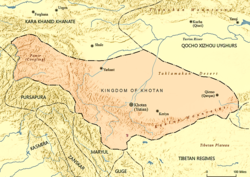Reino de Jotán
El reino de Jotán o de Hotán fue un antiguo reino budista ubicado en la ruta de la seda, en el tramo que corría a lo largo del borde sur del desierto de Taklamakán en la cuenca del Tarim. La zona se encuentra en lo que actualmente es Sinkiang, China.
| ||||
 | ||||
| Capital | Hotan | |||
| Idioma principal | idioma gāndhārī (siglos III y IV).[web 1] | |||
| Religión | budismo | |||
| Gobierno | monarquía | |||
| Período histórico | Antigüedad y Edad Media | |||
| • La ciudad de Yarkant se anexa Jotán. Yulin abdica y se convierte en el rey de Ligui | 56 | |||
| • | 1006 | |||

Nombres primitivos editar
Anverso: leyenda Kharoshthi "Del gran rey de reyes, rey de Jotán, Gurgamoya.
Reverso leyenda en chino: "Moneda de veinticuatro granos de cobre". British Museum.
El nombre del reino en la región actualmente denominada Khotan ha tenido varias denominaciones. La población local hacia el siglo III lo escribía Khotana en escritura Kharoşţhī; y Hvatäna- en Brāhmī en los textos algo posteriores, al desarrollarse la lengua se convirtió en Hvamna y Hvam, por lo que en escritos más recientes aparece citado como Hvam kşīra ‘la tierra de Khotan’. La zona se conocía al oeste aún antes de que la –t- fuera modificada, tal como es frecuente en persa moderno. Pero debido a influencias diversas los pobladores locales lo escribían también Gaustana, cuando estuvieron bajo la influencia del prestigio del sánscrito budista, y Yūttina, cuando el prestigio del reinado chino en Śacu se encontró en su apogeo durante el siglo IX. Para los tibetanos durante los siglos VII y VIII la zona se denominaba Li y la ciudad capital era Hu-ten, Hu-den, Hu-then y Yvu-then.
Capital editar
La antigua ciudad de Jotán era la capital del reino. El nombre chino (pinyin) es Hetian (和田). También se utilizaba el nombre Hotán. A partir de la dinastía Han hasta por lo menos la dinastía Tang los chinos lo conocían como Yutian 于闐, 于窴, o 於闐.
Construida en un oasis, sus moreras permitían la producción y exportación de seda y alfombras de seda, además de otros productos de la ciudad tales como nefrita, jade y cerámica.
Referencias editar
Véase también editar
Bibliografía editar
- Bailey, H. W. (1961). Indo-Scythian Studies being Khotanese Texts. Volume IV. Translated and edited by H. W. Bailey. Indo-Scythian Studies, Cambridge, The University Press. 1961.
- Bailey, H. W. (1979). Dictionary of Khotan Saka. Cambridge University Press. 1979. 1st Paperback edition 2010. ISBN 978-0-521-14250-2.
- Beal, Samuel. 1884. Si-Yu-Ki: Buddhist Records of the Western World, by Hiuen Tsiang. 2 vols. Trans. by Samuel Beal. London. Reprint: Delhi. Oriental Books Reprint Corporation. 1969.
- Beal, Samuel. 1911. The Life of Hiuen-Tsiang by the Shaman Hwui Li, with an Introduction containing an account of the Works of I-Tsing. Trans. by Samuel Beal. London. 1911. Reprint: Munshiram Manoharlal, New Delhi. 1973.
- Emmerick, R. E. 1967. Tibetan Texts Concerning Khotan. Oxford University Press, London.
- Emmerick, R. E. 1979. Guide to the Literature of Khotan. Reiyukai Library, Tokyo.
- Grousset, Rene. 1970. The Empire of the Steppes: A History of Central Asia. Trans. by Naomi Walford. New Brunswick, New Jersey. Rutgers University Press. ISBN 0-8135-1304-9
- Hill, John E. July, 1988. "Notes on the Dating of Khotanese History." Indo-Iranian Journal, Vol. 31, No. 3. See: [2] (enlace roto disponible en Internet Archive; véase el historial, la primera versión y la última). for paid copy of original version. Updated version of this article is available for free download (with registration) at: [3]
- Hill, John E. 2004. The Peoples of the West from the Weilüe 魏略 by Yu Huan 魚豢: A Third Century Chinese Account Composed between 239 and 265 CE. Draft annotated English translation. [4]
- Hill, John E. (2009) Through the Jade Gate to Rome: A Study of the Silk Routes during the Later Han Dynasty, 1st to 2nd Centuries CE. John E. Hill. BookSurge, Charleston, South Carolina. ISBN 978-1-4392-2134-1.
- Legge, James. Trans. and ed. 1886. A Record of Buddhistic Kingdoms: being an account by the Chinese monk Fâ-hsien of his travels in India and Ceylon (A.D. 399-414) in search of the Buddhist Books of Discipline. Reprint: Dover Publications, New York. 1965.
- Watters, Thomas (1904–1905). On Yuan Chwang's Travels in India. London. Royal Asiatic Society. Reprint: 1973.
- Hill, John E. (2003). Draft version of: "The Western Regions according to the Hou Hanshu. 2nd Edition." "Appendix A: The Introduction of Silk Cultivation to Khotan in the 1st Century CE." [5]
- Martini, G. (2011). "Mahāmaitrī in a Mahāyāna Sūtra in Khotanese - Continuity and Innovation in Buddhist Meditation", Chung-Hwa Buddhist Journal 24: 121-194. ISSN 1017-7132. [6]
Enlaces externos editar
- La diseminación del arte y la cultura de la India hacia Asia Central y China
- Página de monedas de Jotán
- Discusión sobre el final del reino de Jotán (enlace roto disponible en Internet Archive; véase el historial, la primera versión y la última).
- Descubrimiento de un pequeño templo antiguo
Error en la cita: Existen etiquetas <ref> para un grupo llamado «web», pero no se encontró la etiqueta <references group="web"/> correspondiente.